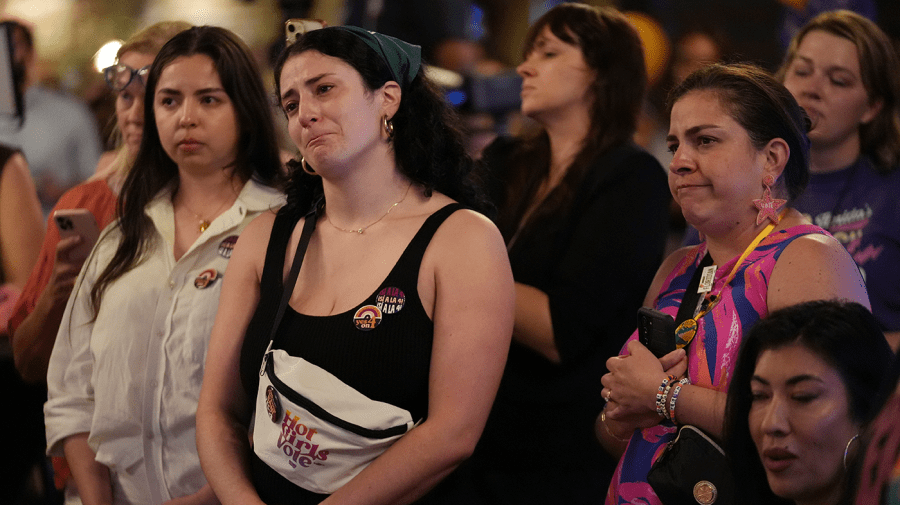
Florida’s abortion rights groups are taking stock after a narrow loss in last week’s ballot referendum but say the fight to overturn the state’s six-week abortion ban isn’t over.
Florida became the first state to reject an abortion rights amendment since Roe v. Wade was overturned in 2022, leaving Gov. Ron DeSantis’s (R-Fla.) six-week ban in place. Although the amendment, which sought to protect abortion access to the point of fetal viability, was approved by 57 percent of voters, it fell short of passing due to Florida’s supermajority threshold, which requires any amendment to have a 60 percent approval rating.
This requirement paired with unprecedented involvement from the DeSantis administration presented a unique set of challenges to pass the amendment. People on both sides of the debate say the uphill battle to enshrine abortion protections in solid red Florida’s constitution will persist.
“Republicans can’t get cocky,” Florida Republican strategist Ford O’Connell said. “I think [the amendment is] going to be tried again in the state of Florida, and Republicans have to be ready to knock them down.”
Natasha Sutherland, senior adviser to the official “Yes on 4” movement, told The Hill that the push for increased abortion protections “isn’t done,” but she is unsure there’s an “appetite” for another effort in 2026.
“Lick our wounds, figure out how things went, what went wrong or didn’t and then lobby,” she said about immediate next steps.
Abortion rights advocates raised nearly $100 million for their cause while DeSantis’s committee against the measure only raised about $6.3 million. Given this funding gap, Sutherland attributed the failure of the measure’s passing largely to DeSantis leveraging his gubernatorial powers and state funds.
“Because we got very, very close, I can’t imagine that they’re going to allow us to get this close ever again,” Sutherland said.
Meanwhile, the “Vote No on 4” campaign attributes much of the campaign’s success to DeSantis’s “leadership” throughout the process.
“He was intimately ingrained in the campaign,” John Stemberger, head of regional field directors for the “No” campaign, told The Hill. “You can’t replace that. That’s huge.”
The Florida governor, who was a vocal leader against the amendment, tried to stop the measure from qualifying for the ballot, threatened television stations for airing campaign advertisements in support of the initiative and launched a website with the state health agency blasting the amendment.
“They did [everything] and anything they had really to spread a whole lot of mis- and disinformation around the state of abortion care in Florida and what the amendment would or would not do,” Sutherland said about DeSantis’s involvement.
“It’s sort of death by paper cuts,” she added.
Still, given the support the campaign received from some Florida Republicans, Sutherland sees a “way in” to voters through improved grassroots work across the state.
The “No on 4” campaign is also reassessing how to appeal to voters, given almost six in 10 voters said yes to the measure. President-elect Trump, a registered Florida voter, said he voted against the ballot measure after previously insisting the six-week ban was too strict.
“It’s clear that we have a lot of work to do in persuading people on this issue,” Stemberger said, noting the importance of “how you frame the issue” of abortion.
A large talking point of the campaign against the ballot measure focused on the lack of definitions in the proposed amendment. Stemberger pointed to the vagueness of terms like “viability” and “healthcare professional,” calling the amendment “highly extreme” and “deceptive.”
“The vote is either pro-choice or pro-life depending on how the question is asked,” Stemberger said.
Ballot summaries in Florida are capped at 75 words, leaving little room for definitions and explanations. In addition to the limited words allotted, Florida has another unique requirement: the 60 percent supermajority threshold.
“Ballot initiatives are a new way to actually fight and also help, depending on the state, boost your candidates who are on the ballot as well,” said O’Connell, the GOP strategist. “That’s why I think you’re going to see more states probably go to the 60 [percent] vote limit because of the ability to maneuver around elections.”
The Sunshine State is one of a handful of states that require a supermajority vote to pass amendments. Florida voters passed the amendment to instill the threshold in 2006, with a 58 percent majority.
“The reality is, because of Florida’s constitution, a minority of Florida voters have decided that Amendment 4 will not be adopted,” Lauren Brenzel, campaign director for Yes on 4, told supporters after the results came in last Tuesday night. “A majority of Floridians, in what is the most conservative presidential election in Florida’s history, voted to end Florida’s abortion ban.”
In response to the criticism about the minority vote determining the outcome, Stemberger said that everyone must “play by the rules.”
“The rules are not majority rule,” he said. “The rules are 60 percent.”
Stemberger added that he is part of a larger coalition advocating to increase the amendment threshold to a two-third majority vote like that of New Hampshire. Still, this may not benefit efforts to maintain the six-week ban in Florida, according to O’Connell.
“Florida has been known to elect Republicans statewide but has also shown itself to be very liberal when it comes to ballot measures,” he said, noting the legalization of medical marijuana as well as increases to minimum wages.














